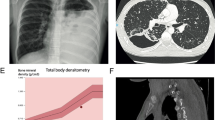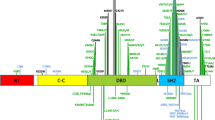Abstract
Of all the causes identified for the disease hyper-immunoglobulinemia E syndrome (HIES), a homozygous mutation in tyrosine kinase2 (TYK2) and heterozygous mutations in STAT3 are implicated the defects in Jak/STAT signalling pathway in the pathogenesis of HIES. Mutations of STAT3 have been frequently clinically identified in autosomal-dominant (AD) HIES patients’ cells, and therefore, the genotype of STAT3 has been associated with the phenotype of HIES. Here, we conducted studies on the functional loss of the seven specific STAT3 mutations correlated with AD-HIES. Using STAT3-null human colon carcinoma cell line A4 cells, we generated seven mutants of STAT3 bearing single mutations clinically identified in AD-HIES patients’ cells and studied the functional loss of these mutants in IL-6-Jak/STAT3 signalling pathway. Our results show that five STAT3 mutants bearing mutations in the DNA-binding domain maintain the phosphorylation of Tyr705 and the ability of dimerization while the other two with mutations in SH2 domain are devoid of the phosphorylation of Try705 and abrogate the dimerization in response to IL-6. The phosphorylation of Ser727 in these mutants shows diversity in response to IL-6. These mutations eventually converge on the abnormalities of the IL-6/Gp130/Jak2-mediated STAT3 transactivation on target genes, indicative of the dysregulation of JAK/STAT signalling present in HIES.






Similar content being viewed by others
References
Al Khatib S, Keles S, Garcia-Lloret M, Karakoc-Aydiner E, Reisli I, Artac H, Camcioglu Y, Cokugras H, et al. 2009 Defects along the T(H)17 differentiation pathway underlie genetically distinct forms of the hyper IgE syndrome. J. Allergy Clin. Immunol. 124 342–348, 348 e341–345
Avery DT, Ma CS, Bryant VL, Santner-Nanan B, Nanan R, Wong M, Fulcher DA, Cook MC and Tangye SG 2008 STAT3 is required for IL-21-induced secretion of IgE from human naive B cells. Blood 112 1784–1793
Becker S, Groner B and Muller CW 1998 Three-dimensional structure of the Stat3beta homodimer bound to DNA. Nature 394 145–151
Buckley RH, Wray BB and Belmaker EZ 1972 Extreme hyperimmunoglobulinemia E and undue susceptibility to infection. Pediatrics 49 59–70
Costa-Pereira AP, Tininini S, Strobl B, Alonzi T, Schlaak JF, Is'harc H, Gesualdo I, Newman SJ, et al. 2002 Mutational switch of an IL-6 response to an interferon-gamma-like response. Proc. Natl. Acad. Sci. USA 99 8043–8047
Darnell JE, Jr. 1997 STATs and gene regulation. Science 277 1630–1635
Darnell JE, Jr., Kerr IM and Stark GR 1994 Jak-STAT pathways and transcriptional activation in response to IFNs and other extracellular signaling proteins. Science 264 1415–1421
Davis SD, Schaller J and Wedgwood RJ 1966 Job's Syndrome. Recurrent, "cold", staphylococcal abscesses. Lancet 1 1013–1015
Decker T and Kovarik P 2000 Serine phosphorylation of STATs. Oncogene 19 2628–2637
Freeman AF and Holland SM 2010 Clinical manifestations of hyper IgE syndromes. Dis. Markers 29 123–130
Freeman AF, Kleiner DE, Nadiminti H, Davis J, Quezado M, Anderson V, Puck JM and Holland SM 2007 Causes of death in hyper-IgE syndrome. J. Allergy Clin. Immunol. 119 1234–1240
Gerhartz C, Heesel B, Sasse J, Hemmann U, Landgraf C, Schneider-Mergener J, Horn F, Heinrich PC and Graeve L 1996 Differential activation of acute phase response factor/STAT3 and STAT1 via the cytoplasmic domain of the interleukin 6 signal transducer gp130. I. Definition of a novel phosphotyrosine motif mediating STAT1 activation. J. Biol. Chem. 271 12991–12998
Ginsberg M, Czeko E, Muller P, Ren Z, Chen X and Darnell JE Jr 2007 Amino acid residues required for physical and cooperative transcriptional interaction of STAT3 and AP-1 proteins c-Jun and c-Fos. Mol. Cell Biol. 27 6300–6308
Grimbacher B, Holland SM, Gallin JI, Greenberg F, Hill SC, Malech HL, Miller JA, O'Connell AC and Puck JM 1999a Hyper-IgE syndrome with recurrent infections--an autosomal dominant multisystem disorder. New Engl. J. Med. 340 692–702
Grimbacher B, Holland SM and Puck JM 2005 Hyper-IgE syndromes. Immunol. Rev. 203 244–250
Grimbacher B, Schaffer AA, Holland SM, Davis J, Gallin JI, Malech HL, Atkinson TP, Belohradsky BH, et al. 1999b Genetic linkage of hyper-IgE syndrome to chromosome 4. Am. J. Hum. Genet. 65 735–744
Guerois R, Nielsen JE and Serrano L 2002 Predicting changes in the stability of proteins and protein complexes: a study of more than 1000 mutations. J. Mol. Biol. 320 369–387
Happel KI, Dubin PJ, Zheng M, Ghilardi N, Lockhart C, Quinton LJ, Odden AR, Shellito JE, et al. 2005 Divergent roles of IL-23 and IL-12 in host defense against Klebsiella pneumoniae. J. Exp. Med. 202 761–769
Heinrich PC, Behrmann I, Muller-Newen G, Schaper F and Graeve L 1998 Interleukin-6-type cytokine signalling through the gp130/Jak/STAT pathway. Biochem. J. 334 297–314
Holland SM, DeLeo FR, Elloumi HZ, Hsu AP, Uzel G, Brodsky N, Freeman AF, Demidowich A, et al. 2007 STAT3 mutations in the hyper-IgE syndrome. New Engl. J. Med. 357 1608–1619
Jiao H, Toth B, Erdos M, Fransson I, Rakoczi E, Balogh I, Magyarics Z, Derfalvi B, et al. 2008 Novel and recurrent STAT3 mutations in hyper-IgE syndrome patients from different ethnic groups. Mol. Immunol. 46 202–206
Kretzschmar AK, Dinger MC, Henze C, Brocke-Heidrich K and Horn F 2004 Analysis of Stat3 (signal transducer and activator of transcription 3) dimerization by fluorescence resonance energy transfer in living cells. Biochem. J. 377 289–297
Liu L, McBride KM and Reich NC 2005 STAT3 nuclear import is independent of tyrosine phosphorylation and mediated by importin-alpha3. Proc. Natl. Acad. Sci. USA 102 8150–8155
Ma CS, Chew GY, Simpson N, Priyadarshi A, Wong M, Grimbacher B, Fulcher DA, Tangye SG and Cook MC 2008 Deficiency of Th17 cells in hyper IgE syndrome due to mutations in STAT3. J. Exp. Med. 205 1551–1557
Ma J, Zhang T, Novotny-Diermayr V, Tan AL and Cao X 2003 A novel sequence in the coiled-coil domain of Stat3 essential for its nuclear translocation. J. Biol. Chem. 278 29252–29260
Milner JD, Brenchley JM, Laurence A, Freeman AF, Hill BJ, Elias KM, Kanno Y, Spalding C, et al. 2008 Impaired T(H)17 cell differentiation in subjects with autosomal dominant hyper-IgE syndrome. Nature 452 773–776
Minegishi Y 2009 Hyper-IgE syndrome. Curr. Opin. Immunol. 21 487–492
Minegishi Y, Saito M, Tsuchiya S, Tsuge I, Takada H, Hara T, Kawamura N, Ariga T, et al. 2007 Dominant-negative mutations in the DNA-binding domain of STAT3 cause hyper-IgE syndrome. Nature 448 1058–1062
Murakami M, Hibi M, Nakagawa N, Nakagawa T, Yasukawa K, Yamanishi K, Taga T and Kishimoto T 1993 IL-6-induced homodimerization of gp130 and associated activation of a tyrosine kinase. Science 260 1808–1810
Ng PC and Henikoff S 2002 Accounting for human polymorphisms predicted to affect protein function. Genome Res. 12 436–446
Papanastasiou AD, Mantagos S, Papanastasiou DA and Zarkadis IK 2010 A novel mutation in the signal transducer and activator of transcription 3 (STAT3) gene, in hyper-IgE syndrome. Mol. Immunol. 47 1629–1634
Regis G, Pensa S, Boselli D, Novelli F and Poli V 2008 Ups and downs: the STAT1:STAT3 seesaw of Interferon and gp130 receptor signalling. Semin. Cell Dev. Biol. 19 351–359
Renner ED, Rylaarsdam S, Anover-Sombke S, Rack AL, Reichenbach J, Carey JC, Zhu Q, Jansson AF, et al. 2008 Novel signal transducer and activator of transcription 3 (STAT3) mutations, reduced T(H)17 cell numbers, and variably defective STAT3 phosphorylation in hyper-IgE syndrome. J. Allergy Clin. Immunol. 122 181–187
Renner ED, Torgerson TR, Rylaarsdam S, Anover-Sombke S, Golob K, LaFlam T, Zhu Q and Ochs HD 2007 STAT3 mutation in the original patient with Job's syndrome. New Engl. J. Med. 357 1667–1668
Schindler C and Darnell JE Jr 1995 Transcriptional responses to polypeptide ligands: the JAK-STAT pathway. Annu. Rev. Biochem. 64 621–651
Schindler C, Levy DE and Decker T 2007 JAK-STAT signaling: from interferons to cytokines. J. Biol. Chem. 282 20059–20063
Schuringa JJ, Jonk LJ, Dokter WH, Vellenga E and Kruijer W 2000 Interleukin-6-induced STAT3 transactivation and Ser727 phosphorylation involves Vav, Rac-1 and the kinase SEK-1/MKK-4 as signal transduction components. Biochem. J. 347 Pt 1 89–96
Schuringa JJ, Timmer H, Luttickhuizen D, Vellenga E and Kruijer W 2001 c-Jun and c-Fos cooperate with STAT3 in IL-6-induced transactivation of the IL-6 respone element (IRE). Cytokine 14 78–87
Schymkowitz JW, Rousseau F, Martins IC, Ferkinghoff-Borg J, Stricher F and Serrano L 2005 Prediction of water and metal binding sites and their affinities by using the Fold-X force field. Proc. Natl. Acad. Sci. USA 102 10147–10152
Seidel HM, Milocco LH, Lamb P, Darnell JE Jr, Stein RB and Rosen J 1995 Spacing of palindromic half sites as a determinant of selective STAT (signal transducers and activators of transcription) DNA binding and transcriptional activity. Proc. Natl. Acad. Sci. USA 92 3041–3045
Shuai K, Horvath CM, Huang LH, Qureshi SA, Cowburn D and Darnell JE Jr 1994 Interferon activation of the transcription factor Stat91 involves dimerization through SH2-phosphotyrosyl peptide interactions. Cell 76 821–828
Starr R, Willson TA, Viney EM, Murray LJ, Rayner JR, Jenkins BJ, Gonda TJ, Alexander WS, et al. 1997 A family of cytokine-inducible inhibitors of signalling. Nature 387 917–921
Stephanou A and Latchman DS 2005 Opposing actions of STAT-1 and STAT-3. Growth Factors 23 177–182
Wen Z and Darnell JE Jr 1997 Mapping of Stat3 serine phosphorylation to a single residue (727) and evidence that serine phosphorylation has no influence on DNA binding of Stat1 and Stat3. Nucleic Acids Res. 25 2062–2067
Wen Z, Zhong Z and Darnell JE Jr 1995 Maximal activation of transcription by Stat1 and Stat3 requires both tyrosine and serine phosphorylation. Cell 82 241–250
Yang J, Huang J, Dasgupta M, Sears N, Miyagi M, Wang B, Chance MR, Chen X, et al. 2010 Reversible methylation of promoter-bound STAT3 by histone-modifying enzymes. Proc. Natl. Acad. Sci. USA 107 21499–21504
Yu H, Pardoll D and Jove R 2009 STATs in cancer inflammation and immunity: a leading role for STAT3. Nat. Rev. Cancer 9 798–809
Zhong Z, Wen Z and Darnell JE Jr 1994 Stat3: a STAT family member activated by tyrosine phosphorylation in response to epidermal growth factor and interleukin-6. Science 264 95–98
Acknowledgements
This work was supported by grants NCET-08-0260 from Ministry of Education and 2009DFA30990 from Ministry of Science and Technology of the People's Republic of China; 0708WCGA149 from the Gansu Provincial Science and Technology to JY.
Author information
Authors and Affiliations
Corresponding author
Additional information
Corresponding editor: Seyed E Hasnain
[He J, Shi J, Xu X, Zhang W, Wang Y, Chen X, Du Y, Zhu N, Zhang J, Wang Q and Yang J 2012 STAT3 mutations correlated with hyper-IgE syndrome lead to blockage of IL-6/STAT3 signalling pathway. J. Biosci. 37 1–15] DOI
Rights and permissions
About this article
Cite this article
He, J., Shi, J., Xu, X. et al. STAT3 mutations correlated with hyper-IgE syndrome lead to blockage of IL-6/STAT3 signalling pathway. J Biosci 37, 243–257 (2012). https://doi.org/10.1007/s12038-012-9202-x
Received:
Accepted:
Published:
Issue Date:
DOI: https://doi.org/10.1007/s12038-012-9202-x




